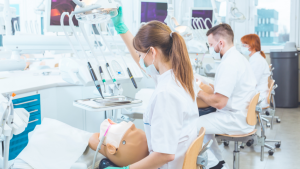How accurate are your implant records?

Digital versus analogue – Morven McCauley explains what studies have revealed as the most precise techniques for implant record taking.
The primary goal of fabricating any implant retained restoration is to achieve a precise connection to the underlying implant, ensuring a passive fit. Any errors and deficiencies presented in the record taking process will have an overall negative impact on the final prosthesis.
Inaccuracies will not only affect the restorative fit and passivity but also its aesthetics, cleansibility and potential longevity. Any strain to the restoration, connection to the underlying implant or contribution to soft tissue inflammation may result in ultimate failure.
There are several factors that can affect the accuracy of information transferred from the patient’s mouth to the laboratory.
Impression material
It is well documented that the use of both medium body polyethers and addition silicones produce similarly accurate casts. This is due to their high rigidity to stabilise the impression copings in position. The stability prevents any distortions and discrepancies during the heavy forces applied on removal.
Increased deformities can however occur in the presence of significant undercuts and non-parallel adjacent implants.
Impression tray
The impression tray selection can also play a role in overall impression accuracy. There is ample documentation confirming metal and rigid plastic impression trays show reduced discrepancies for both open and closed tray techniques.
Impressions taken with flexible plastic trays are found to produce considerable inaccuracies. Therefore, they tend to be avoided for implant restorative procedures.
To be open or closed
With analogue record taking, there are two main types of impression technique: closed tray and open tray impressions. On measuring the fine discrepancies and distortions of study models following these two techniques, the open tray impression technique tends to produce models with reduced discrepancies.
To splint or not to splint
Another factor to consider in an analogue process is recording the position of multiple implants in scenarios of splinted implants or full arch prosthesis. There are two main pathways to record these longer-span restorations, with splinted or non-splinted impression copings.
Non-splinted impressions have unlinked impression copings, which may lead to errors caused by movement or angulation of any of the components during the process. The splinted technique involves connecting the implant impression copings with a linking material, most commonly resin. The grouping of the impression copings reduces this risk of shifting and or tilting, therefore reducing discrepancies.
While both techniques can be successful, studies have shown that the splinted implant techniques tend to have fewer errors and are generally the preferred option for optimum results in multi-unit restorations.
The digital era
The introduction of digital workflows in implant dentistry has provided many prospective advantages over conventional analogue techniques. For digital data, the ease of its transfer, recurring accessibility to records and its storage, all dramatically outweigh its analogue counterpart.
Improved patient experience and the simplicity of in-surgery processes also adds to the benefits of digital dentistry and explain its widespread increasing application by clinicians. But how accurate is it?
Digital versus analogue
In the narrative review by Michelinakis (Michelinakis et al, 2021), intra-oral scanning was found to have high accuracy with minimal deviations, especially in single or short-span cases. Any deviations fell within the acceptable clinical limits.
There were however some notable findings with comparisons in the recording of edentulous arches. In the comparison of digital impressions and conventional splinted, custom tray full arch impressions, there was no superiority. However, the contrary was discovered in the comparison of intra-oral scanning and conventional non-splinted, open or close tray impressions. The digital full arch records proved to have the higher accuracy rate.
With the increasing popularity of photogrammetry in full arch record taking, it would be interesting to see if this digital pathway will now supersede the accuracy of analogue splinted records.
Scan body type
The review by Michelinakis also concluded that the accuracy of digital impressions was found to be highest with the use of an all PEEK, one-part, cylindrical scan body in comparison to a titanium scan body range.
In conclusion, intra-oral scanning and digital workflows appear to have proportionate 3D accuracy in comparison to analogue implant impressions, based mainly on in vitro studies and systematic reviews.
Continuing advancements in technology, patient comfort, simplicity and the advantages of data storage and transfer may see digital workflows becoming the preferred record taking process in implant dentistry in the very near future.
Additionally, with the rise in artificial intelligence applications, how will this play a role in record taking and lab processing in the coming years?
References
- Michelinakis G, Apostolakis D, Kamposiora P, Papavasiliou G, Özcan M. The direct digital workflow in fixed implant prosthodontics: a narrative review. BMC Oral Health. 2021 Jan 21;21(1):37. doi: 10.1186/s12903-021-01398-2. PMID: 33478459; PMCID: PMC7819204.
Catch Morven’s previous Implant Insights columns:
Follow Dentistry.co.uk on Instagram to keep up with all the latest dental news and trends.







